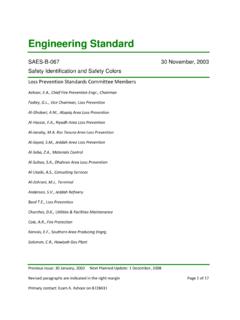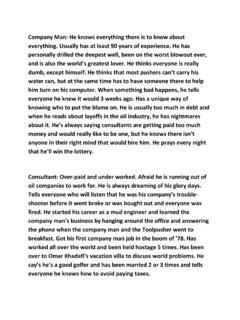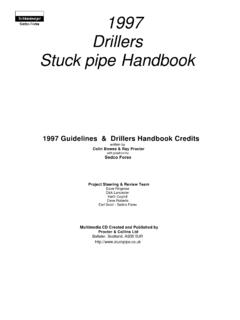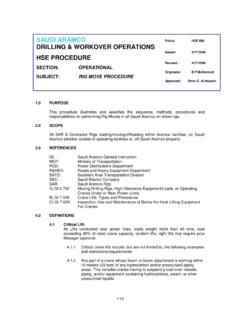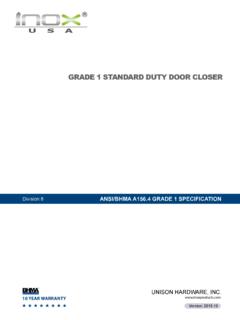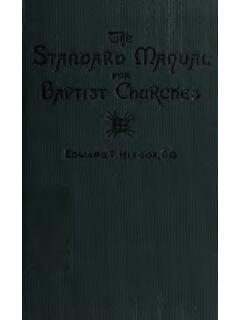Transcription of Saudi Aramco Engineering Standard - Oil Field Trash
1 Previous Issue: 30 November, 2003 Next Planned Update: 1 October, 2008 Revised paragraphs are indicated in the right margin Page 1 of 24 Primary contact: Thani S. Al-Anizi on 874-7955 Engineering Standard SAES-P-111 28 January, 2004 Grounding Electrical Systems Designs & Automation standards Committee Members Ishwait, Basel A., Chairman Al -Hamrani, Majed M., Vice Chairman Almadi, Soliman M. Badrani, Hamed S. Bahamdan, Mohammad O. Fateel, Adel M. Ghamdi, Abdulaziz A. (PDD) Hamood, Abdulrazaq A. Hassouneh, Awwad S. Heikoop, Dirk J. Shaikh-Nasser, Ahmed N. Zayan, Mahmoud B. Saudi Aramco DeskTop standards Document Responsibility: Electrical Systems Designs & Automation SAES-P -111 Issue Date: 28 January, 2004 Next Planned Update: 1 October, 2008 Grounding Page 2 of 24 Table of Contents 1 2 2 Conflicts, Deviations, and 2 3 2 4 4 5 Materials and 6 6 Substation 9 7 Grounding 9 8 System 10 9 Equipment 12 10 Offshore Platform 16 11 Fence 16 12 Tank 18 13 Lightning 18 14 Static Electricity 18 1 Scope This Standard prescribes minimum mandatory requirements for design and installation of grounding systems and lightning protection systems for Saudi Aramco facilities.
2 This document may not be attached to nor made a part of purchase orders. Document Responsibility: Electrical Systems Designs & Automation SAES-P -111 Issue Date: 28 January, 2004 Next Planned Update: 1 October, 2008 Grounding Page 3 of 24 2 Conflicts, Deviations, and Commentary If there are any conflicts between this Standard and associated purchasing, project or Engineering documents, this Standard shall take precedence. The exception is if an approved Waiver form SA 6409-ENG has been included with the purchasing documents. Any conflicts between this Standard and other applicable Saudi Aramco Engineering standards (SAESs), Materials System Specifications (SAMSSs), Standard Drawings (SASDs), or industry standards , codes, and forms shall be resolved in writing by the company or buyer representative through the Manager, Consulting Services Department of Saudi Aramco , Dhahran. Direct all requests to deviate from this Standard in writing to the company or buyer representative, who shall follow internal company procedure SAEP-302 and forward such requests to the Manager, Consulting Services Department of Saudi Aramco , Dhahran.
3 The designation "Commentary" is used to label a sub-paragraph that contains comments that are explanatory or advisory. These comments are not mandatory, except to the extent that they explain mandatory requirements contained in this SAES. 3 References The selection of material and equipment, and the design, construction, maintenance, and repair of equipment and facilities covered by this Standard shall comply with the latest edition of the references listed below, unless otherwise noted. Saudi Aramco References Saudi Aramco Engineering Procedure SAEP-302 Instructions for Obtaining a Waiver of a Mandatory Saudi Aramco Engineering Requirement Document Responsibility: Electrical Systems Designs & Automation SAES-P -111 Issue Date: 28 January, 2004 Next Planned Update: 1 October, 2008 Grounding Page 4 of 24 Saudi Aramco Engineering standards SAES-B-070 Bulk Plants SAES-M-006 Saudi Aramco Security and General Purpose Fencing SAES-J-902 Electrical Systems for Instrumentation SAES-P-100 Basic Power System Design Criteria SAES-P-104 Wiring Methods and Materials SAES-P-107 Overhead Distribution Systems SAES-T Series Communications Engineering standards SAES-X-400 Cathodic Protection of Buried Pipelines Saudi Aramco Materials System Specification 15-SAMSS-502 Medium Voltage Power Cables 5 kV though 35 kV Saudi Aramco Library Drawing DD-950022 Grounding Connections Details Ground Rod to Ground Grid Saudi Aramco Standard Drawings AB-036387 Tank Grounding AA-036572 Grounding Arrangement for Disconnect Switch Structure Industry Codes and standards American National standards Institute ANSI C2 National Electrical Safety Code American Petroleum Institute Document Responsibility.
4 Electrical Systems Designs & Automation SAES-P -111 Issue Date: 28 January, 2004 Next Planned Update: 1 October, 2008 Grounding Page 5 of 24 API RP 2003 Protection Against Ignitions Arising out of Static, Lightning, and Stray Currents Institute of Electrical and Electronics Engineers IEEE 80 Guide for Safety in Alternating-Current Substation Grounding IEEE 81 Guide for Measuring Earth Resistivity, Ground Impedance, and Earth Surface Potentials of a Ground System IEEE 142 Recommended Practice for Grounding of Industrial and Commercial Power Systems IEEE 399 IEEE Recommended Practice for Power Systems Analysis (Brown Book) IEEE 1100 Powering and Grounding Sensitive Electronic Equipment International Electrotechnical Commission IEC 61662 Assessment of Risk of Damage Due to Lightning IEC 61024-1 Protection of Structures Against Lightning IEC 61024-1- 1 Protection of Structures Against Lightning Part 1: General Principles Section 1: Guide A Selection of Protection Levels for Lightning Protection Systems National Fire Protection Association NFPA 70 National Electrical Code NFPA 99 Health Care Facilities NFPA 780 Lightning Protection Code Underwriters Laboratories Document Responsibility: Electrical Systems Designs & Automation SAES-P -111 Issue Date: 28 January, 2004 Next Planned Update: 1 October, 2008 Grounding Page 6 of 24 UL 96 Lightning Protection Components UL 96A Installation Requirements for Lightning Protection Systems UL 467 Grounding and Bonding Equipment 4 General Except as noted in , grounding and ground system installation shall be designed in accordance with IEEE 142 and meet the requirements of ANSI/NFPA 70 (NEC), and ANSI C2, as supplemented or amended by this Standard .
5 Requirements for specific facilities are as follows: a) Health Care Facility grounding shall meet additional requirements of NFPA 99; b) Communications System grounding shall be in accordance with the SAES-T Series; c) SAES-J-902 shall take precedence over this Standard for grounding of process control instrumentation and process control systems. Refer to SAES-J-902 for grounding sensitive electronic equipment associated with process control systems. Commentary Notes : It is intended that the terminology used in this Standard be consistent with the NEC. Sensitive electronic equipment not covered by SAES-J-902 should be grounded in accordance with the recommendations of IEEE 1100. Except as specifically noted, electrical installations in residential facilities, recreational facilities, schools and office buildings (including office buildings associated with plants and industrial facilities) shall be grounded in accordance with the industry standards referenced in and are not required to meet the additional requirements contained in this Standard .
6 Document Responsibility: Electrical Systems Designs & Automation SAES-P -111 Issue Date: 28 January, 2004 Next Planned Update: 1 October, 2008 Grounding Page 7 of 24 Measurements of earth resistivity and ground impedance shall be made in accordance with IEEE 81 or by a non-contacting ground resistivity mapping instrument (Geonics or equal). In soils exceeding 5000 ohm-cm. the measurements shall be taken or verified by a non-contacting ground resistivity-mapping instrument. Commentary Note : Special techniques may be needed to avoid errors in measuring earth resistivity in areas congested with existing grounding systems, existing cathodic protection systems, and/or existing underground metal structures. Calculations of allowable and actual step and touch potentials shall be done in accordance with IEEE 80 using the following parameters: A body weight of 50 kg shall be assumed. Duration of ground faults used in calculations for maximum allowable step and touch potential shall be the time (based on known operating conditions) it would take for the backup breaker to clear the fault with a minimum of sec.
7 And a maximum of sec. Ground fault current shall be the higher of the line to line to ground or the symmetrical line to ground fault current. In calculations of the grid current, the current division factor must be assumed to be unless calculations based on known actual site conditions are provided to justify a lower number. Commentary : The current division factor is used to account for the current that returns to the source though an overhead ground wire rather than through the substation ground grid and earth. For calculations of allowable step and touch potentials, the resistivity of the surface material (rho sub s) shall be assumed to be 3,000 ohm-meters Document Responsibility: Electrical Systems Designs & Automation SAES-P -111 Issue Date: 28 January, 2004 Next Planned Update: 1 October, 2008 Grounding Page 8 of 24 for a minimum 75 mm thick pad of clean crushed rock, 10,000 ohm-meters for a minimum 50 mm layer of asphalt, and 200 ohm-meters for a minimum 75 mm layer of concrete.
8 For all other surface materials, the lower of 100 ohm-meters or the actual measured top layer (minimum m layer thickness) soil resistivity shall be used. Calculations of mesh voltage and ground potential rise (See IEEE 80) shall be based on actual measured soil resistivity. If native material is replaced by fill, calculations shall incorporate the effect of the measured soil resistivity of the fill. Commentary Note : IEEE 399 "IEEE Recommended Practice for Power Systems Analysis (Brown Book) provides additional information on analysis of ground grids for substations. The techniques covered in IEEE 80 are most useful for analyzing and designing ground grids for substations connected to solidly grounded high voltage lines. The guidance in NEC and this Standard will be most useful in other portions of the electrical system. Soil resistivity of backfill material used for ground grids and ground rods shall be the same as or less than that of the surrounding soil.
9 Commissioning tests shall be performed to verify that resistance to remote earth of substation ground grids and/or ground electrodes used for system grounding meet design requirements. 5 Materials and Installation This section also applies to electrical installations in residential facilities, recreational facilities and office buildings. Conductors used as grid conductors, grounding electrode conductors, equipment ground conductors, or bonding conductors in grounding systems shall: a) Be soft or annealed copper. Document Responsibility: Electrical Systems Designs & Automation SAES-P -111 Issue Date: 28 January, 2004 Next Planned Update: 1 October, 2008 Grounding Page 9 of 24 b) If larger than 35 mm (#2 AWG) be stranded. Stranding of ground conductors shall comply with the stranding requirements of SAES-P-104. c) Except for grid conductors used in substations for potential control purposes be insulated when used in direct contact with soil less than 70 ohm-meters resistivity.
10 D) If used for grid conductors in substations for potential control purposes be bare and if used in soils less than 70 ohm-meters resistivity be tinned. e) If insulated have a green jacket or a green jacket with yellow stripes. When isolated ground equipment grounding conductors are installed per IEEE 1100, they must be labeled or color coded to distinguish them from Standard equipment grounding conductors. f) If exposed above grade in a severe corrosion area (as defined in SAES-P-104) be insulated. g) If buried and used for grids and/or interconnection of ground rods be minimum 70 mm (2/0 AWG). h) If used for connection of equipment to ground rods or ground grid be minimum 25 mm (#4 AWG). Exception : See SAES-P-107 for pole ground wires. Commentary Note : Soils in Saudi Aramco areas which are lower than 70 ohm-meters resistivity normally have high salt content and are corrosive to copper. In areas where cathodic protection is present, galvanized steel ground rods are recommended.
